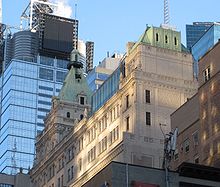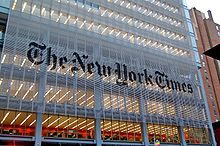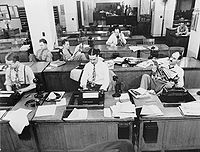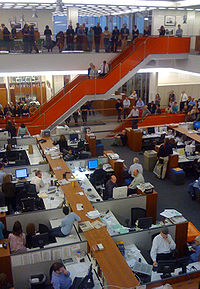|

The New York Times is an American daily newspaper founded and continuously published in New York City since 1851. Although it remains both the largest local metropolitan newspaper in the United States as well as being third largest overall, behind The Wall Street Journal and USA Today, the weekday circulation of the paper has fallen precipitously in recent years to fewer than one million copies daily for the first time since the 1980s. Nicknamed "The Gray Lady" and long regarded within the industry as a national "newspaper of record", the Times is owned by The New York Times Company, which also publishes 18 other regional newspapers including the International Herald Tribune and The Boston Globe. The company's chairman is Arthur Ochs Sulzberger Jr., whose family has controlled the paper since 1896.
The paper's motto, printed in the upper left-hand corner of the front page, is "All the News That's Fit to Print." It is organized into sections: News, Opinions, Business, Arts, Science, Sports, Style, and Features. The Times stayed with the eight-column format for several years after most papers switched to six columns, and it was one of the last newspapers to adopt color photography. The Times has won 104 Pulitzer Prizes, the most of any news organization. Its web site was the most popular American online newspaper Web site as of December 2008, receiving more than 18 million unique visitors in that month.

The Times Square Building, The New York Times' headquarters from 1913 to 2007
The New York Times was founded on September 18, 1851, by journalist and politician Henry Jarvis Raymond, who was then a Whig and who would later be the second chairman of the Republican National Committee, and former banker George Jones as the New-York Daily Times. Sold at an original price of one cent per copy, the inaugural edition attempted to address the various speculations on its purpose and positions that preceded its release

We shall be Conservative, in all cases where we think Conservatism essential to the public good;—and we shall be Radical in everything which may seem to us to require radical treatment and radical reform. We do not believe that everything in Society is either exactly right or exactly wrong;—what is good we desire to preserve and improve;—what is evil, to exterminate, or reform.
The paper changed its name to The New York Times in 1857. The newspaper was originally published every day except Sunday, but on April 21, 1861, due to the demand for daily coverage of the Civil War, The Times, along with other major dailies, started publishing Sunday issues. One of the earliest public controversies in which the paper was involved was the Mortara Affair, an affair that was the object of 20 editorials in The Times alone.
The paper's influence grew during 1870–71, when it published a series of exposés of Boss Tweed that led to the end of the Tweed Ring's domination of New York's City Hall In the 1880s, The Times transitioned from supporting Republican candidates to becoming politically independent; in 1884, the paper supported Democrat Grover Cleveland in his first presidential election. While this move hurt The Times' readership, the paper regained most of its lost ground within a few years.
The Times was acquired by Adolph Ochs, publisher of the Chattanooga Times, in 1896. The following year, he coined the paper's slogan, "All The News That's Fit To Print".
This was a jab at competing papers such as the New York World and the New York Journal American which were known for lurid yellow journalism. Under his guidance, The New York Times achieved international scope, circulation, and reputation. In 1904, The Times received the first on-the-spot wireless transmission from a naval battle, a report of the destruction of the Russian fleet at the Battle of Port Arthur in the Yellow Sea from the press-boat Haimun during the Russo-Japanese war. In 1910, the first air delivery of The Times to Philadelphia began. The Times' first trans-Atlantic delivery to London occurred in 1919. In 1920, a "4 A.M. Airplane Edition" was sent by plane to Chicago so it could be in the hands of Republican convention delegates by evening.

The Times newsroom, 1942
In the 1940s, the paper extended its breadth and reach. The crossword began appearing regularly in 1942, and the fashion section in 1946. The Times began an international edition in 1946. The international edition stopped publishing in 1967, when The Times joined the owners of the New York Herald Tribune and the Washington Post to publish the International Herald Tribune in Paris. The paper bought a classical radio station (WQXR) in 1946. In addition to owning WQXR, the newspaper also formerly owned its AM sister, WQEW (1560 AM). The classical music format was simulcast on both frequencies until the early 1990s, when the big-band and standards music format of WNEW-AM (now WBBR) moved from 1130 AM to 1560. The AM station changed its call letters from WQXR to WQEW. By the beginning of the 21st century, The Times was leasing WQEW to ABC Radio for its Radio Disney format, which continues on 1560 AM. Disney became the owner of WQEW in 2007. On July 14, 2009 it was announced that WQXR was to be sold to WNYC, who on October 8, 2009 moved the station to 105.9 FM and began to operate the station as a non-commercial.
The New York Times is third in national circulation, after USA Today and the Wall Street Journal. The newspaper is owned by The New York Times Company, in which descendants of Adolph Ochs, principally the Sulzberger family, maintain a dominant role. In March 2009, the paper reported a circulation of 1,039,031 copies on weekdays and 1,451,233 copies on Sundays. According to a 2009 The New York Times article circulation has dropped 7.3 percent to about 928,000; this is the first time since the 1980s that it has fallen under one million. In the New York City metropolitan area, the paper costs $2 Monday through Saturday and $5 on Sunday. The Times has won 101 Pulitzer Prizes, more than any other newspaper.
In 2009, The Times began production of local inserts in regions outside of the New York area. Beginning October 16, 2009, a two-page "Bay Area" insert was added to copies of the Northern California edition on Fridays and Sundays. The Times commenced production of a similar Friday and Sunday insert to the Chicago edition on November 20, 2009. The inserts consist of local news, policy, sports, and culture pieces, usually supported by local advertisements.
In addition to its New York City headquarters, The Times has 16 news bureaus in New York State, 11 national news bureaus and 26 foreign news bureaus. The New York Times reduced its page width to 12 inches (300 mm) from 13.5 inches (340 mm) on August 6, 2007, adopting the width that has become the U.S. newspaper industry standard.
Because of its steadily declining sales in recent decades, The Times has been going through a downsizing for several years, offering buyouts to workers and cutting expenses, in common with a general trend among print newsmedia.
The newspaper's first building was located at 113 Nassau Street in New York City. In 1854, it moved to 138 Nassau Street, and in 1858 it moved to 41 Park Row, making it the first newspaper in New York City housed in a building built specifically for its use. The paper moved its headquarters to 1475 Broadway in 1904, in an area called Long Acre Square, which was renamed to Times Square. The top of the building is the site of the New Year's Eve tradition of lowering a lighted ball, which was started by the paper. The building is also notable for its electronic news ticker, where headlines crawled around the outside of the building. It is still in use, but is not operated by The Times. After nine years in Times Square, an Annex was built at 229 West 43rd Street. After several expansions, it became the company's headquarters in 1913, and the building on Broadway was sold in 1961. Until June 2007, The Times, from which Times Square gets its name, was published at offices at West 43rd Street. It stopped printing papers there on June 15, 1997.
The newspaper remained at that location until June 2007, when it moved three blocks south to 620 Eighth Avenue between West 40th and 41st Streets, in Manhattan. The new headquarters for the newspaper, The New York Times Building, is a skyscraper designed by Renzo Piano.

A speech in the newsroom after announcement of Pulitzer Prize winners, 2009
The Ochs-Sulzberger family, one of the United States' newspaper dynasties, has owned The Times since 1896. After the publisher went public in the 1960s, the family continued to exert control through its ownership of the vast majority of Class B voting shares. Class A shareholders are permitted restrictive voting rights while Class B shareholders are allowed open voting rights. Dual-class structures caught on in the mid-20th century as families such as the Grahams of the Washington Post Company sought to gain access to public capital without losing control. Dow Jones & Co., publisher of The Wall Street Journal, had a similar structure and was controlled by the Bancroft family; the company was later bought by the News Corporation in 2007
The Ochs-Sulzberger family trust controls roughly 88 percent of the company's class B shares. Any alteration to the dual-class structure must be ratified by six of eight directors who sit on the board of the Ochs-Sulzberger family trust. The Trust board members are Daniel H. Cohen, James M. Cohen, Lynn G. Dolnick, Susan W. Dryfoos, Michael Golden, Eric M. A. Lax, Arthur O. Sulzberger, Jr. and Cathy J. Sulzberger.
Turner Catledge, the top editor at The New York Times for almost two decades, wanted to hide the ownership influence. Sulzberger routinely wrote memos to his editor, each containing suggestions, instructions, complaints, and orders. When Catledge would receive these memos he would erase the publisher’s identity before passing them to his subordinates. Catledge thought that if he removed the publisher’s name from the memos it would protect reporters from feeling pressured by the owner.
This newspaper is organized in three sections, including the magazine.
1. News: Includes International, National, Washington, Business, Technology, Science, Health, Sports, The Metro Section, Education, Weather, and Obituaries.
2. Opinion: Includes Editorials, Op-Eds and Letters to the Editor.
3. Features: Includes Arts, Movies, Theatre, Travel, NYC Guide, Dining & Wine, Home & Garden, Fashion & Style, Crossword, The New York Times Book Review, The New York Times Magazine, and Week in Review
Some sections, such as Metro, are only found in the editions of the paper distributed in the New York–New Jersey–Connecticut Tri-State Area and not in the national or Washington, D.C. editions. Aside from a weekly roundup of reprints of editorial cartoons from other newspapers, The Times does not have its own staff editorial cartoonist, nor does it feature a comics page or Sunday comics section. In September 2008, The Times announced that it would be combining certain sections effective October 6, 2008, in editions printed in the New York metropolitan area. The changes folded the Metro Section into the main International / National news section and combined Sports and Business (except Saturday through Monday, when Sports is still printed as a standalone section). This change also included having the name of the Metro section be called New York outside of the Tri-State Area. The presses used by The Times allow four sections to be printed simultaneously; as the paper had included more than four sections all days except Saturday, the sections had to be printed separately in an early press run and collated together. The changes will allow The Times to print in four sections Monday through Wednesday, in addition to Saturday. The Times' announcement stated that the number of news pages and employee positions will remain unchanged, with the paper realizing cost savings by cutting overtime expenses. According to Russ Stanton, editor of the Los Angeles Times, a competitor, the newsroom of The New York Times is twice the size of the Los Angeles Times, which currently has a newsroom of 600.
The Times has had a strong presence on the Web since 1996, and has been ranked one of the top Web sites. Accessing some articles requires registration, though this can be bypassed in some cases through Times RSS feeds. The website had 555 million pageviews in March 2005. The domain nytimes.com attracted at least 146 million visitors annually by 2008 according to a Compete.com study. The Times Web site ranks 59th by number of unique visitors, with over 20 million unique visitors in March 2009 making it the most visited newspaper site with more than twice the number of unique visitors as the next most popular site. Also, as of May 2009, nytimes.com produced 22 of the 50 most popular newspaper blogs.
In September 2005, the paper decided to begin subscription-based service for daily columns in a program known as TimesSelect, which encompassed many previously free columns. Until being discontinued two years later, TimesSelect cost $7.95 per month or $49.95 per year, though it was free for print copy subscribers and university students and faculty. To work around this, bloggers often reposted TimesSelect material, and at least one site once compiled links of reprinted material. On September 17, 2007, The Times announced that it would stop charging for access to parts of its Web site, effective at midnight the following day, reflecting a growing view in the industry that subscription fees cannot outweigh the potential ad revenue from increased traffic on a free site. In addition to opening almost the entire site to all readers, The Times news archives from 1987 to the present are available at no charge, as well as those from 1851 to 1922, which are in the public domain. Access to the Premium Crosswords section continues to require either home delivery or a subscription for $6.95 per month or $39.95 per year. Times columnists including Nicholas Kristof and Thomas Friedman had criticized TimesSelect, with Friedman going so far as to say "I hate it. It pains me enormously because it’s cut me off from a lot, a lot of people, especially because I have a lot of people reading me overseas, like in India ... I feel totally cut off from my audience."
The Times is also the first newspaper to offer a video game as part of its editorial content, Food Import Folly by Persuasive Games. reCAPTCHA is currently helping to digitize old editions of The New York Times.
The Times Reader is a digital version of The Times. It was created via a collaboration between the newspaper and Microsoft. Times Reader takes the principles of print journalism and applies them to the technique of online reporting. Times Reader uses a series of technologies developed by Microsoft and their Windows Presentation Foundation team. It was announced in Seattle in April 2006 by Arthur Ochs Sulzberger Jr., Bill Gates, and Tom Bodkin. In 2009 the Times Reader 2.0 was rewritten in Adobe Air.
In 2008, The Times created an app for the iPhone and iPod touch which allowed users to download articles to their mobile device enabling them to read the paper even when they were unable to receive a signal
Source Wikipedia
|